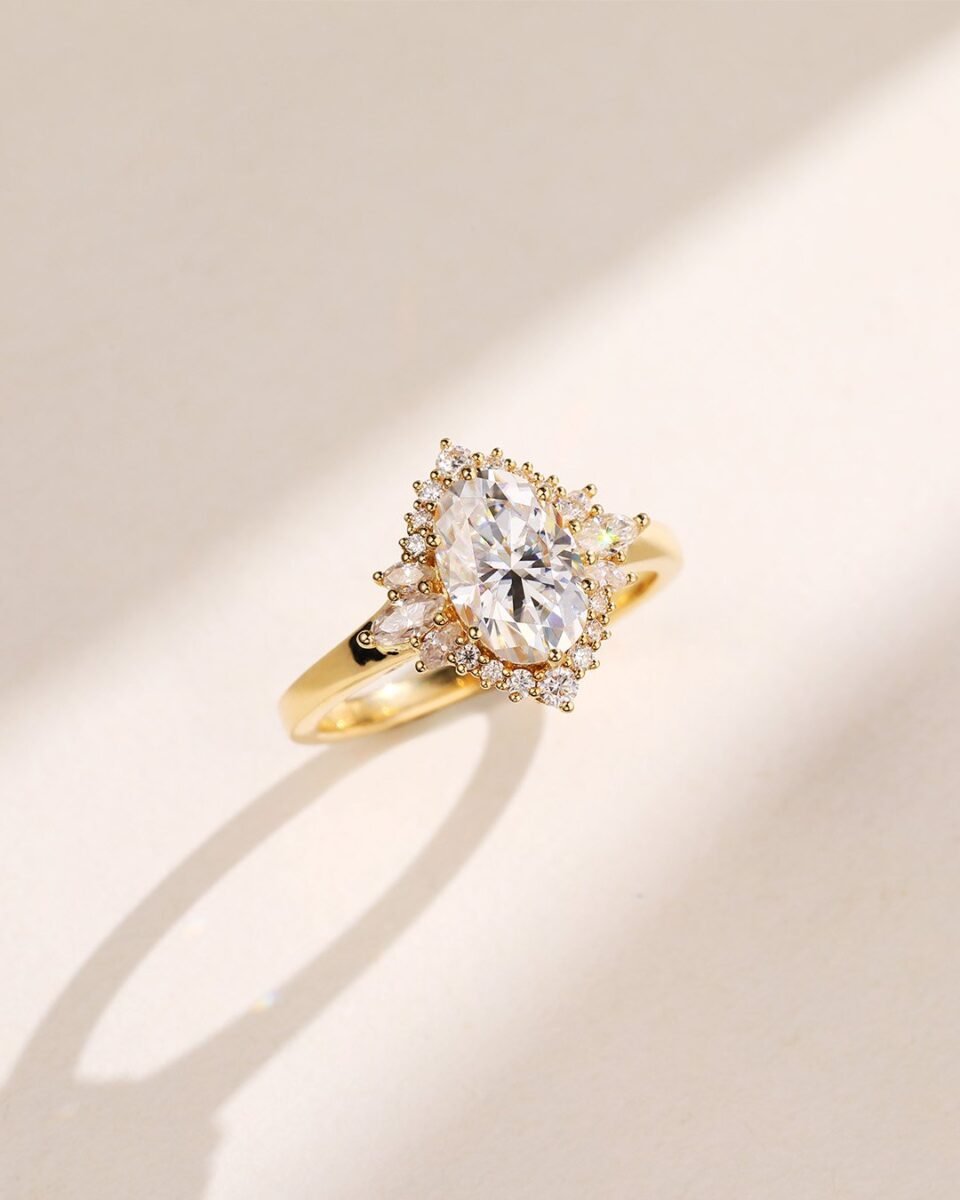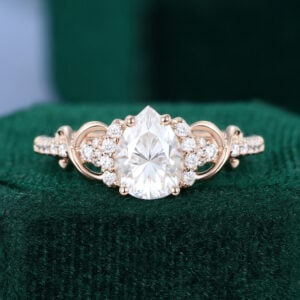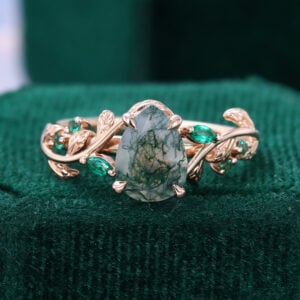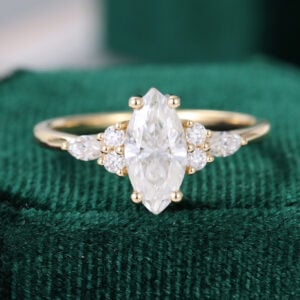Last updated on November 24, 2025
Key Takeaways
- The “Rule” is a Myth: The “3 months’ salary” rule was a marketing campaign, not a tradition.
- Real Spending: While the national average is ~$6,000, most couples actually spend between $1,000 and $3,000.
- Smart Savings: Choosing Moissanite or Lab-Grown Diamonds can save you up to 90% without sacrificing sparkle.
- Priority: Your budget should be based on your personal financial health, not societal pressure.
It’s the question that haunts almost every proposer: “How much am I actually supposed to spend?”
You’ve likely heard the old adage that you should spend “three months’ salary” on an engagement ring. If that number makes your palms sweat, take a deep breath. That “rule” wasn’t created by financial advisors or relationship experts—it was a brilliant marketing campaign from the 1930s designed to sell more diamonds.
In 2025, the rules have changed. Modern couples are prioritizing down payments on homes, dream honeymoons, and financial stability over crushing debt. While the national average might give you a benchmark, your budget should be determined by your personal finances and your partner’s values, not by an outdated societal standard.
In this guide, we’ll break down the real average costs, debunk the myths, and help you calculate a number that feels right for you—without the pressure.

Table Of Contents:
- The Myth of the “Three Months’ Salary” Rule
- The Reality: What is the Average Cost in 2025?
- 4 Factors That Should Actually Determine Your Budget
- How to Get the Look for Less (Smart Shopping 9 Tips)
- FAQs About Engagement Ring Costs
The Myth of the “Three Months’ Salary” Rule
Before you start looking at price tags, let’s clear up where this pressure comes from.
The idea that you need to spend a specific portion of your income began in the 1930s (during the Great Depression, ironically) by De Beers, the diamond cartel. Their initial campaign suggested spending one month’s salary. By the 1980s, as the economy boomed, their marketing materials quietly bumped that suggestion up to two months, and eventually, the “three months” figure became cultural folklore.
Why it’s outdated: Today’s economic landscape is vastly different. Student loans, rising housing costs, and the desire for experiences (like travel) mean that spending 25% of your annual income on a single piece of jewelry is often not financially prudent.
The Reality: What is the Average Cost in 2025?
If the old rules don’t apply, what are people actually spending?
According to recent industry studies (like The Knot), the national average cost of an engagement ring in the US hovers between $5,500 and $6,000.
However, “Average” can be misleading. This number is skewed by a small percentage of buyers spending upwards of $50,000.
- The Median Spend: A more realistic look shows that most couples spend between $1,000 and $3,000.
- The Trend: There is a rapidly growing segment of buyers choosing rings under $1,000, driven by the popularity of alternative gemstones like Moissanite and Moss Agate.
The Takeaway: If you aren’t spending $6,000, you aren’t “cheap”—you are actually in the majority.
| Category | Average Cost (USD) |
|---|---|
| U.S. National Average | $5,200 – $6,000 |
| Most Common Spending Range | $1,000 – $3,000 |
| Mid-Atlantic Regional Average | $6,900 |
| Midwest Regional Average | $4,900 |
Most Loved Engagement Rings
Explore more 👉 affordable engagement rings.
4 Factors That Should Actually Determine Your Budget
Forget the calculators. Here are the four real factors that should dictate your number:
1. Your Current Financial Health
Do you have credit card debt? Are you saving for a house? An engagement ring is a symbol of a future together, and starting that future with manageable finances is far more romantic than starting it with debt. Look at your disposable income and savings, not your gross salary.
2. Your Partner’s Expectations
This is the most critical factor. Does your partner care about brand names and natural diamonds? Or do they value sustainability, unique designs, and size? Many partners today prefer a larger, more brilliant stone (like Moissanite) over a smaller, more expensive natural diamond. A transparent conversation—or asking their best friend—can save you thousands.
3. The “Usage” of the Ring
Is your partner active? Do they work with their hands? If so, spending a fortune on a delicate, high-maintenance setting might not be practical. Sometimes, a durable, affordable, and replaceable option is smarter for daily wear.
4. Alternative Materials
The center stone largely dictates the price of a ring.
- Natural Diamond: The most expensive option.
- Lab-Grown Diamond: Chemically identical to natural, but ~30-50% cheaper.
- Moissanite: More brilliant than a diamond, almost as hard (9.25 Mohs), but costs fraction (approx. 1/10th) of the price.
| Gemstone Type | Avg. Price (USD/Carat) | Mohs Hardness | Unique Features |
|---|---|---|---|
| Natural Diamond | $4,000 – $10,000+ | 10 | Ultimate hardness, classic and rare |
| Lab-Grown Diamond | Much lower than natural diamonds | 10 | High value, ethical & eco-friendly |
| Sapphire | $400 – $2,000 | 9 | Wide color variety, highly durable |
| Ruby | $2,500 – $5,000 | 9 | Symbol of love, rich red tones |
| Emerald | $2,000 – $3,500 | 7.5 – 8 | Vintage elegance, vivid green color |
| Moissanite | $400 – $1,500 | 9.25 | Exceptional brilliance, outstanding value |
Related: 8 Popular Diamond Alternatives for Your Engagement Ring
Most Loved Moissanite Engagement Rings
Explore more 👉 moissanite engagement rings.
How to Get the Look for Less (Smart Shopping 9 Tips)
If you have a budget in mind but want a ring that looks well above that price point, here is how to maximize your value:
Tip 1: Switch to Moissanite or Lab Gemstones
This is the single most effective way to save money. A 2-carat natural diamond can cost $15,000+. A top-quality 2-carat Moissanite often costs under $1,000. Visually, Moissanite offers even more fire and brilliance, making it a stunning choice for the modern bride.
Tip 2: No Insistence on The Highest Quality (Center Stone)
The “4Cs” are the key factors that determine gemstone pricing: Cut, Color, Clarity, and Carat.
You don’t need the highest grade—like clarity, choose “eye clean” (SI2-VS2) stones (flawless to the naked eye), which balance beauty and cost. The higher the 4C grade, the higher the price.
Want to know how to get the best value when buying a diamond? View Diamond 4Cs Guide to uncover the secrets behind diamond pricing.
Tip 3: Opt for Elongated Shapes (The “Size” Hack)
Shape matters more than you think. Elongated cuts like Oval, Pear, or Marquise naturally appear larger than round cuts of the same carat weight because they have a larger surface area. They also have the added benefit of making the wearer’s finger look longer and more slender.
Tip 4: Be Strategic with Your Setting (Halo Effect)
The setting style plays a huge role in visual impact. A Halo setting (a circle of small stones surrounding the center stone) can make your center gem appear up to 0.5 carats larger. This allows you to buy a smaller, less expensive center stone while still achieving a “big ring” look. Conversely, if you want to keep the price as low as possible, a simple Solitaire setting saves on craftsmanship costs.
Tip 5: Choose 10k or 14k Gold over 18k or Platinum
14k gold is the industry standard for a reason. It is more durable and scratch-resistant than 18k gold (which is softer) and significantly cheaper than Platinum. It looks virtually identical to the untrained eye but keeps the price down. This allows you to allocate more of your budget toward the center stone, creating a stronger visual impact.
👉 Learn more in our Platinum vs. Gold vs. Silver Guide.
Tip 6: Go for Unique Stones (Moss Agate & Emerald)
Non-traditional stones are trending heavily. Moss Agate, with its unique green inclusions, offers a one-of-a-kind look that feels organic and personal, often at a very accessible price point compared to clear stones.
Tip 7: Choose a Thinner Band (The Petite Illusion)
Here is a designer’s secret: a thinner band makes the center stone look significantly larger by comparison. Choosing a band width between 1.5mm and 1.8mm (often called a “petite” band) can make a 1-carat stone look like a 1.5-carat stone, giving you more visual impact without spending a penny more on the gem.
Tip 8: Consider a Bridal Set
Planning ahead pays off. Buying a Bridal Ring Set (which includes the engagement ring and the matching wedding band) is often more cost-effective than purchasing them separately. Plus, you guarantee a perfect fit and style match without the headache of hunting for a band later.
Tip 9: Shop During Key Sales Events
Timing is everything. Jewelry prices can fluctuate, but shopping during major sales events like Black Friday, Cyber Monday, or Valentine’s Day sales can save you an additional 15-25%. Signing up for our newsletter is the best way to catch these deals before they expire.
Conclusion: Love is Not Measured by Price
At the end of the day, the engagement ring is a symbol of your commitment, not a proof of purchase. The “right” amount to spend is the amount that allows you to propose with confidence and joy, without worrying about your bank account.
Whether your budget is $500 or $5,000, you can find a piece that tells your unique love story.
Ready to see what your budget can actually buy? We have broken down the best options for every price tier. Check out our detailed guide: 👉 Engagement Ring Price Guide: What You Can Get for Every Budget
FAQs About Engagement Ring Costs
There’s no fixed rule. While the U.S. average is around $5,500, many couples spend between $1,000 and $3,000. The best budget is one that fits your finances and makes both you and your partner happy.
Not really. It was created as a marketing campaign in the 20th century. Modern couples are moving away from this outdated idea, focusing instead on personal financial comfort and shared goals.
Lab-grown diamonds have the same physical and chemical properties as natural diamonds but typically cost 30–60% less. They are also conflict-free and eco-friendly, making them a popular choice.
Moissanite is one of the most affordable stones, offering incredible brilliance at a fraction of the cost of diamonds. Silver or 10K gold bands can also help save money without compromising style.
Both options have advantages. Online jewelers usually offer better prices and variety, while in-store shopping allows you to see and try on rings in person.
It depends on personal preference. Some couples value size for visual impact, while others prioritize cut, clarity, or ethical sourcing. A well-cut smaller stone can often sparkle more than a larger poorly cut one.
Absolutely. With modern options like Moissanite and lab-created gemstones, you can find stunning, high-quality engagement rings between $500 and $1,000 that look just as impressive as more expensive options. View our 15 Best Engagement Rings Under $1000
Traditionally, the proposer sets the budget. However, many modern couples discuss finances together before the proposal to ensure the purchase aligns with their future financial goals (like buying a house).






